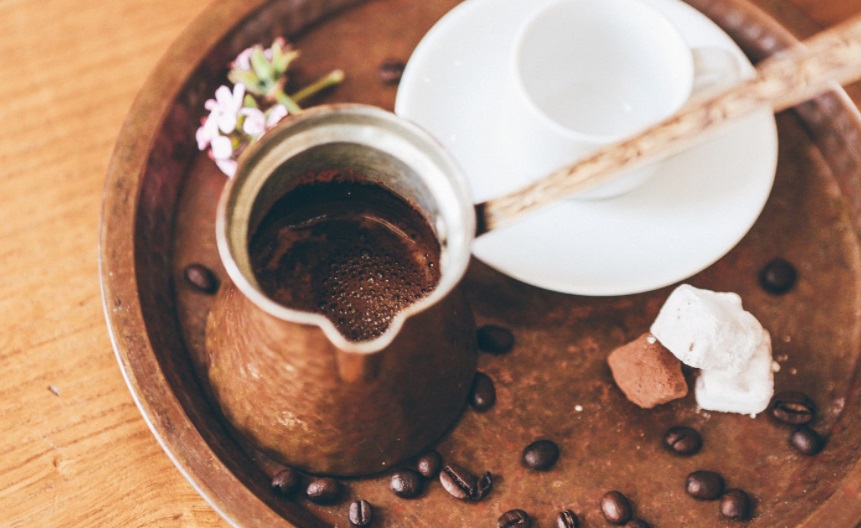
Dive into the aromatic world of Greek and Turkish coffee, two beverages steeped in history and rich with cultural significance. Greek coffee, often savored in the sun-kissed cafes of Athens, and Turkish coffee, a staple in the bustling bazaars of Istanbul, both offer more than just a caffeine kick—they are deeply ingrained in the social fabric of their respective cultures.
Despite their shared origins in the Ottoman Empire, these coffees have evolved uniquely, reflecting the local traditions and communal life of Greece and Turkey.
Key Takeaways
- Brewing Brilliance: Discover the distinctive brewing techniques of Greek and Turkish coffee, where precision meets tradition, resulting in cups bursting with flavor.
- Serving with Style: Unveil the artful serving traditions, from the foam-topped Greek “briki” to the Turkish “cezve,” each telling its own story.
- Taste the Tradition: Explore the rich flavor profiles and regional variations, where each sip narrates the history and geography of its origin.
- Local Lore: Delve into the regional nuances within Greek and Turkish coffee cultures, showcasing the diversity within unity.
- Beyond the Brew: Uncover the surprising health benefits and the pivotal role these coffees play in cultural ceremonies and daily life.
Brewing Methods: A Step-by-Step Guide
Greek Coffee Brewing
- Start with Cold Water: Pour cold water into a briki, the traditional Greek coffee pot. The amount depends on the number of servings.
- Add Sugar to Taste: Before heating, mix in sugar according to your preference: unsweetened, moderately sweet, or very sweet.
- Coffee Time: Sprinkle finely ground Greek coffee over the water. Don’t stir yet.
- Slow Heat: Place the briki on low heat. Watch as the coffee dissolves and begins to warm.
- First Stir: Once the coffee granules have settled, give it a gentle stir.
- Watch the Foam: As the coffee heats, a foam, known as “kaimaki,” forms. This is crucial – it’s all about the foam!
- The Perfect Moment: Right before the coffee boils and the foam rises, remove it from the heat.
- Serve with Care: Pour the coffee into small cups, ensuring the foam is evenly distributed.
Turkish Coffee Brewing
- Water Measurement: Use the coffee cup to measure water, pouring it into a cezve (Turkish coffee pot).
- Sugar Decision: Add sugar now if you like it sweet. Adjust according to taste.
- Add Coffee: Sprinkle finely ground Turkish coffee over the water. No stirring yet.
- Low Flame: Heat the mixture gently. Patience is key here.
- Stirring Time: Once the coffee settles and begins to warm, stir it slowly.
- Foam Watch: Look out for the foam forming as the coffee nears boiling.
- Heat Halting: Just before boiling over, remove the cezve from the heat.
- Serve Right: Pour the coffee into cups, ensuring each gets its share of the precious foam.
Greek Coffee Flavors
Greek coffee offers a rich, robust taste, often with a sweet undertone if sugar is added.
Additives: Typically, Greek coffee is enjoyed without additives, though sugar levels vary.
Sweetness Levels: From unsweetened (sketos) to very sweet (vary glykos), choose how you like your coffee’s sweetness.
Turkish Coffee Flavors
Turkish coffee is known for its intense, bold flavors, sometimes enhanced with spices like cardamom.
Sugar and Spice: Like Greek coffee, sugar is added before brewing, but Turkish coffee often includes spices, creating a unique, aromatic experience.
Flavor Depth: Expect a full-bodied taste, with potential notes of spices, depending on the region and personal preferences.
Greek Coffee Serving Rituals
When it comes to serving Greek coffee, the ritual is as much about community as it is about the beverage itself. The coffee is poured into small, often ornate cups, which are designed to keep the coffee warm and to enhance the sipping experience. The serving process is deliberate, aiming to ensure that the cherished foam—kaimaki—is equally distributed among each cup. In Greece, coffee is more than a drink; it’s a reason to gather, chat, and connect.
Turkish Coffee Serving Rituals
Turkish coffee takes serving to an artistic level. The coffee is poured into intricate, often colorful cups called “fincan,” ensuring the rich foam tops each serving. A key ritual in Turkish coffee culture is the practice of fortune-telling. Once you finish your cup, the grounds left at the bottom are swirled, then flipped upside down on the saucer. The patterns formed are used to tell fortunes, a tradition that adds a mystical element to the coffee-drinking experience.
Coffee in Greek Culture
In Greece, coffee is a cornerstone of social life. Cafes are bustling hubs where people of all ages come to socialize, discuss, and enjoy life—often over a cup of Greek coffee. Offering a guest a cup of coffee is a sign of hospitality and friendship, a tradition that underscores the Greek ethos of community and kinship.
Coffee in Turkish Culture
Similarly, in Turkey, coffee is a vital component of social interaction. Whether in homes or cafes, serving coffee is a gesture of welcome and respect. It’s not just about the drink but the experience of sharing, conversing, and often, engaging in the playful art of fortune-telling with coffee grounds. This tradition enriches the coffee experience, making it an integral part of Turkish cultural and social fabric.
Health Benefits
Greek and Turkish coffee aren’t just cultural staples; they pack a health punch too! Both are rich in antioxidants, which help combat free radicals, reducing inflammation and the risk of certain diseases. Moreover, their caffeine content can boost brain function, improving mood, reaction time, and memory.
Interestingly, the traditional unfiltered brewing method retains more beneficial compounds, making each sip a small but potent contributor to your daily antioxidant intake.
FAQs
What are the main taste differences between Greek and Turkish coffee?
Greek coffee tends to have a slightly sweeter, more nuanced flavor, often with less bitterness than its Turkish counterpart, which is bolder and can include hints of spices.
Why is foam so important in these coffees?
Foam is not just a sign of a well-brewed cup; it enhances the coffee’s texture and is a cherished part of the drinking experience in both cultures.
How do I choose between Greek and Turkish coffee?
Consider your flavor preferences: if you enjoy a smoother, subtly sweet coffee, go for Greek. If you prefer a robust, potentially spiced cup, Turkish might be your pick.
Final Thoughts
Greek and Turkish coffee are much more than morning pick-me-ups; they’re immersive experiences steeped in history and tradition. Each cup offers a unique taste, a dose of health benefits, and a sip of the cultures they represent.









